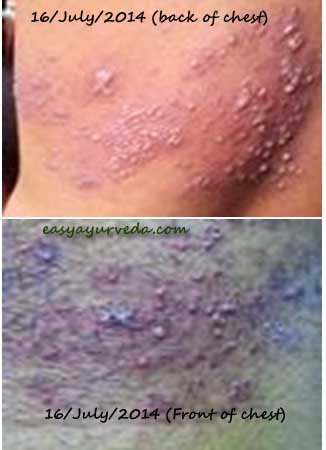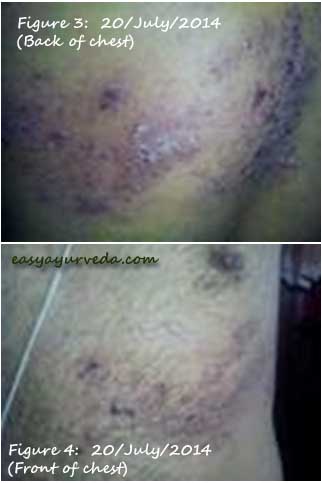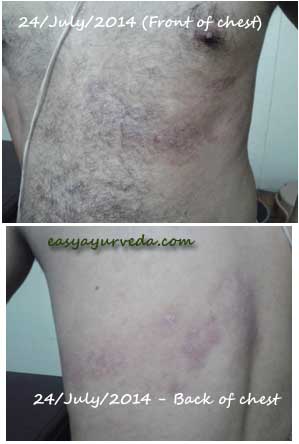Clinical Case Study: Herpes Zoster – By Dr Rangaprasad Bhat
By Prof. Vd. Rangaprasad Bhat.
The varicella zoster virus the causative agent of the measles is the same culprit responsible for the Herpes zoster or Shingles, which is referred technically in Ayurveda as Kaksha.
Table of Contents
Symptoms
Initially even prior to any eruptions, non specific Head Ache, Fever & malaise( a general feeling of discomfort)occurs. Pain of varying degrees in the form of tingling or burning; hyperasthesia (hypersensitivity) or parasthesia (numbness) occurs unilaterally (over one side of the body). Later the pain & burning gets severe like “quick stabbing & agonizing pain” followed by the rashes.
Onset of rashes:-
After 1 or 2 days of incubation, the rashes appear which develops and stays for a period of 15 to 20 days, depending up on one’s immune strength. The Herpes zoster causes skin changes limited to a specific dermatome, normally resulting in a stripe or belt-like pattern that is limited to one side of the body and does not cross the mid line. It is based on this pattern of belt like appearance, that the nomenclature of this disease in Ayurveda has been mentioned as Kaksha.
The area corresponding to the location of the sacred thread is the usual site of Kaksha.
The reference of which is being explained by the Chakrapani’s commentary up on the Charaka chikitsa 12, 11. Which states
“yaj~nopavIta pratima iti yaj~nopavIta vyApya sthAna mAtra vyApakAH sphoTA eva kakShA iti kakShA shabdAkhyAH
The distribution on the oblique part of the trunk reminds the dermatome distribution of the Herpes zoster, which justifies Herpes zoster as the Kaksha.
Common sites of rashes:-
Torso
face
eyes
Other parts of body like.,
Abdomen
Shoulder
Thighs
Penis.
Appearance of rashes:-
Initially the rash appears as Hives and the transforms in the following order.
Hives
Macular lesions
Papules
Vesicles
Vesicles coalesce
Crusts formed
(As healing occurs) crusts wither
Leaves pinkish scars
Gradually becomes hypo pigmented or atrophic.
Complications
Complications of Herpes zoster :-
Although herpes zoster typically resolves within 3–5 weeks, certain complications may arise depending up on the dermatome involved.
Secondary bacterial infection
Motor involvement, including weakness especially in “motor herpes zoster”
Eye involvement: trigeminal nerve involvement (as seen in herpes ophthalmicus) should be treated early and aggressively as it may lead to blindness. Involvement of the tip of the nose in the zoster rash is a strong predictor of herpes ophthalmicus.
Post herpetic neuralgia, a condition of chronic pain following herpes zoster.

Case study 1
Case history of kaksha / Herpes zoster treated with Madhusnuhi Rasayanam
Case 1:-
A male-aged 24 years presented with a history of spontaneous pain in association with pin pricks over the ribs on 14th of July 2014, visited our clinic on 16th of July presenting with rashes on the left thoracic dermatome with macular lesions in association with itching. He was treated with Caps.Madhusnuhi Rasayanam, a preparation of our clinic containing 40 herbs in a dose of 2 caps tid, after food.

As is known with the virility of the disease, it was evolving into the papular and vesicular stages on the next consecutive days. On July 20th the crusts got formed (image attached). On 24th of July the crusts withered away with reminiscent pinkish patches.

During the entire course of the treatment, the patient was not feeling much pain. The herpetic neuralgia was a symptom not felt during the treatment. As a precaution, the patient was asked not to touch the surface of the lesions, and not to wipe with towel over the lesions.
Case study 2
Case 2 :- (Herpes zoster opthalmicus)
A male patient,
aged 48,
Diabetic
Non hypertensive,
with profuse sweating (irrespective of the summer climate)
with good appetite,
but disturbed sleep
and history of Rt.Peri Arthritis for more than 2 years..
On the day of 22.June.2014 the above patient came for a consultation with the presentation of a small colony of blisters in a linear pattern over the mid of the left nasal bridge & over the inner angle of the Lt. Eyebrow.
Associated symptoms were lancinating and spontaneous pain with a slight burning and profound itching.
The symptoms started 3 days prior with onset of fever, he took some OTC product in an conventional medical shop for the same and got subsided by the time he came to the visit on 3rd day of onset.
O/E No crusts were present, no discharges from the blisters.
Eyes showed signs of Conjunctivitis & Episcleritis.
Treatment given:
Two medicines.. one from Ayurveda and other from Homeo.
1. Madhusnuhi Rasayanam capsule (since symptoms where highly indicative & prognostic of involvement of Vata kapha) at 2 TDS a/f dosage.
2. Hypericum of homeo (indicated in burning pain caused by the inflammations of nerve endings). Was selected for emergency management, since the pain was severe surrounding the eyeball.
The patient was asked to report on every two days over the phone of the changes happening over the lesion, since I was not quite comfortable with the eye changes presenting in his case.
As advised , the patient called not on 2nd but on 3rd day of taking Rx and said that he is
60% relieved of itching;
40% that of burning.
The blisters started reducing in size and some blackish crusts were forming over the site of lesions.
Eyes still reddish as on the day of consultation.
He was asked to report the next day.
It was said, Burning sensation 70% & Itching 90% relieved:
eyes showed reduction in the reddish hue over the tarsal conjunctival regions, but the reddish hue near the regions of iris still present, in contrast without any burning or itching inside the eyeball, that was present prior.
Black crusts peeled off by itself. The scar was not prominent.
He was advised to visit the clinic after 3 days ( ie on 29th of June) for further evaluation.
By the time, all symptoms have subsided including the scleritis and conjunctivitis.
The patient was advised to continue the medicine for another 15 days, to reduce the viral load.
Read more about Madhusnuhi Rasayanam
Click to consult Prof. Vd. Rangaprasad Bhat










One comment
yashdeep
very nice case study